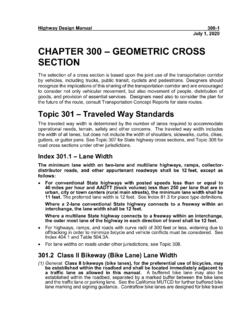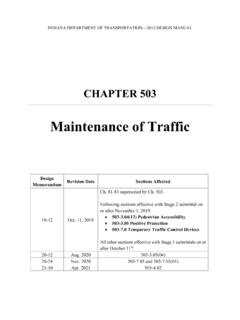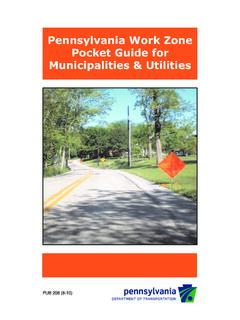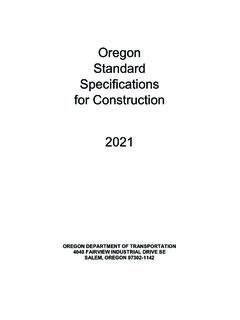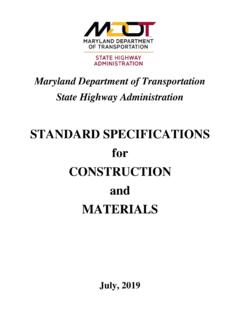Transcription of Tree Trimming Safety - Occupational Safety and Health ...
1 Tree Trimming SafetyFor the Landscaping and Horticultural Services Industry 2 Tree Trimming SafetyTree Trimming SafetyContentsIntroduction What s Inside? ..3 Lesson 1 Take Control of Your Own Safety ..4 Lesson 2 Avoid Shock & Electrocution ..10 Lesson 3 Preventing Falls from Trees ..14 Lesson 4 Avoid Being Struck by Trees or Limbs ..18 Lesson 5 Environmental Hazards ..26 Conclusion ..33 Quiz Yourself Solutions ..36 Written by: Sara Lind, Information specialistMitch Ricketts, Coordinator, Health , Safety and Environmental Quality, K-State Research and ExtensionDisclaimerThis material was produced under grant number 46G3-HT04 and revised and updated under grant number SH-19503-09-60-F-20 from the Occupational Safety and Health Administration, De-partment of Labor.
2 It does not necessarily reflect the views or policies of the Department of Labor, nor does mention of trade names, commercial products, or organizations imply endorsement by the booklet was produced by K-State Research and Extension, Kan-sas State University, Manhattan, information in this publication has been compiled from a vari-ety of sources believed to be reliable and to represent the best current opinion on the subject. However, neither K-State Research and Exten-sion nor its authors guarantee accuracy or completeness of any infor-mation contained in this publication, and neither K-State Research and Extension or its authors shall be responsible for any errors, omis-sions, or damages arising out of the use of this information.
3 Additional Safety measures may be required under particular Trimming Safety 3 This booklet teaches important Safety practices to be followed when manually Trimming tips, along with real accident reports, have been combined to help you protect yourself from the hazards involved in this type of this booklet in conjunction with hands-on Safety training and equipment operator s s Inside? 4 Tree Trimming SafetyGreatest DangersThe most common types of serious tree Trimming accidents are:1. ElectrocutionYou can be seriously injured or killed if you come into contact with an electric line. 2. Falling From TreesYou can be seriously injured or killed if you fall from a Being Struck by Trees or LimbsYou can be seriously injured or killed if you are struck by falling trees or Control of Your Own SafetyLesson 1 Objectives1.
4 Name the most common types of tree Trimming Interpret the meaning of common warning signs and Identify appropriate protective Indicate hazards to be assessed before beginning OSHA Accident Inspection 1099688358An employee was Trimming a tree that was near an overhead power line. The employee misjudged the distance, cut the branch, and it fell on the line. The employee, who was still holding onto the branch, was electrocuted. Always keep a safe distance from power lines. Refer to page 12 for more ReportEmployee Electrocuted When Branch Falls on LineSummary of OSHA Accident Inspection 126621820 While working in a tree, an employee disconnected one lanyard to move around some limbs. After climbing approximately 60 feet up the tree, he disconnected the second lanyard before reconnecting the first.
5 The employee fell and died of head injuries. Always make sure all Safety lines are ReportEmployee Falls After Disconnecting Both LanyardsSummary of OSHA Accident Inspection 125616698An employee was felling trees in a forested area when a limb fell from an adjacent tree and struck him on the head. The employee was wear a hard hat and do a pre-start inspection before beginning ReportEmployee Struck by Falling LimbTree Trimming Safety 5 Help YourselfSafe work habits are important. Here are three important actions you can take to be safe on the job Learn All You Can. To prevent tree Trimming accidents, read and follow directions that come with all climbing and Trimming equipment. While reading, pay attention to Safety instructions and look for warn-ing labels on the equipment.
6 If you have questions, stop and ask your supervisor before you Concentrate on Working you may be tempted to take risky shortcuts. Re-member that an accident can leave you permanently injured or cut your life short. For your Safety and the Safety of those around you, do not take unnecessary risks. No deadline is so pressing you can t take the time to do your work Additional PrecautionsDo not operate machinery or climb trees if you are tired or have taken drugs or alcohol. If you are on medication, discuss with your doctor or pharmacist if you are capable of climbing and operating machinery safely. Choose Safety 6 Tree Trimming SafetySafety Messages and SignsManufacturers put important Safety messages on each piece of equip-ment and in the operator s manual.
7 It is critical to read, understand and follow all Safety messages. The triangle shape is the symbol for caution. The exclamation mark in the center means Pay Attention. In some instances, the triangle-shaped sign will show a picture. Other times, words explain why the sign is Safety messages use the words Caution, Warning and Danger to get your attention. Following are Safety messages and their meanings. Each of these signs will have a written message, and perhaps a picture, about a possibly unsafe means you need to be careful. Follow the directions on the sign or you could get hurt. WARNING is more serious and means you need to follow the directions on the sign or you could be badly hurt or killed.
8 DANGER is the most serious Safety message. If you don t follow the directions, you will be seriously injured or !ELECTRIC SHOCK CAN SERIOUSLY INJURE OR KILL !YOU CAN BECOMECAUGHT IN THEEQUIPMENT SMOVING !HEARINGPROTECTIONREQUIREDI mages displayed in the caution, warning and danger boxes have been recre-ated from images taken with permission from ASAE , FEB1999 (R2005), Safety Trimming Safety 7 When to Wear Hearing ProtectionOSHA Standard (i) (l) requires hearing protection to be worn when sound levels exceed certain limits (generally, a daily average of 85 or 90 decibels, depending on the circumstances). These levels can be measured with a dosimeter. A hearing conservation program requiring hearing tests and other precautions may also be necessary.
9 Check with the equipment operator s manual, as well as your supervisor, for suggestions on hearing protection for each piece of equipment and instructions on how to wear it properly. Hearing Protection Rules of ThumbHearing protection may be needed if:4 You have to raise your voice significantly to be heard by someone three feet After leaving a noisy area, your ears feel plugged or you hear a mild ringing or whooshing noise that goes away after an hour or When you start your car in the morning, the radio is so loud from the evening before that you have to turn it EquipmentCertain equipment is necessary to protect you while Trimming trees. The following protective equipment is Hat A hard hat should be worn to protect your head from falling Gloves may be worn to protect your hands from puncture wounds and , Non-Slip BootsWear boots to keep a firm footing on the ground and reduce the risk of slipping and EquipmentSafety harnesses, belts, ropes, lanyards, slings and carabiners ap-propriate to the job are used to keep you secured in the Operating a Chain saw You Must Wear:Leg ProtectionLeg protection must be worn when performing ground opera-tions.
10 The material should be cut-resistant and cover the entire thigh to the top of each or Safety GlassesGoggles or Safety glasses must be worn at all times to protect your eyes from foreign ShieldA face shield should be worn to protect your face from the kick-back of the machine and Protection Over time, you will lose your hearing if you are exposed to loud noises without protection. Two common types of hearing protection are muffs and plugs. Ear muffs should seal around your ears to properly muffle loud noises. Wash reusable ear plugs with warm, soapy water after each use in order to prevent infection. Discard disposable ear plugs after each use. 8 Tree Trimming SafetyPre-Start InspectionA hazard briefing must be performed before the start of each job.










